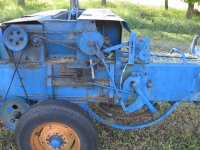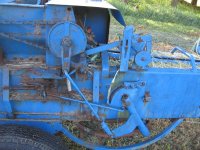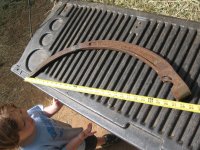Niji
Silver Member
At the end of last season I got a junkyard Ford 532 square baler. It ran quite well, but with the occasional knotter foul-ups one would expect (maybe one bale in 30). It has an odd symptom I've been trying to sort out. During the knotting sequence, the needle rod at the end opposite the needles rides around on a wheel. That wheel where the rod attaches spins around and, as it returns to its rest position, pushes a spring loaded plate, passes it, which in turn snaps behind it so the rod is locked into position with the needles securely out of danger from the plunger. It's like a ratchet.
The trouble is that at least half the time at the end of the cycle, the rod at the wheel end doesn't catch behind the ratchet plate. Then, the needles and the rod smack around as I cut the PTO, and usually before I can get things stopped the rod has finally been smacked around enough that it has popped into position.
Before I even started this year, with baler empty, a spun the knotter sequence through by hand and found it was not catching. I replaced a spring, adjusted a bolt on the wheel the rod attaches to, and got it so that every time I spun it by hand it clicked perfectly in place. Now that I'm in the field, and running at speed with hay, it is about as bad as ever. Any insights into what I'm missing here?
I've luckily only broken a needle twice so far. But it is a very vulnerable situation for needles for sure.
The other trouble is that I've had trouble getting the knotters working right, now. There is no regularity to it--one knotter won't tie, then the other, then both, bill hooks won't clear, twine breaks here and there, twine twisted around stuff, and always presenting in a different way. I've hardly gotten two good bales strung together in two days, and I'm wondering if it is just related to all the crazy slapping around that happens with this needle rod wheel scenario? The needle rod trouble is so regular I can't even tell if the tying trouble would be present if the needle rod was behaving.
The trouble is that at least half the time at the end of the cycle, the rod at the wheel end doesn't catch behind the ratchet plate. Then, the needles and the rod smack around as I cut the PTO, and usually before I can get things stopped the rod has finally been smacked around enough that it has popped into position.
Before I even started this year, with baler empty, a spun the knotter sequence through by hand and found it was not catching. I replaced a spring, adjusted a bolt on the wheel the rod attaches to, and got it so that every time I spun it by hand it clicked perfectly in place. Now that I'm in the field, and running at speed with hay, it is about as bad as ever. Any insights into what I'm missing here?
I've luckily only broken a needle twice so far. But it is a very vulnerable situation for needles for sure.
The other trouble is that I've had trouble getting the knotters working right, now. There is no regularity to it--one knotter won't tie, then the other, then both, bill hooks won't clear, twine breaks here and there, twine twisted around stuff, and always presenting in a different way. I've hardly gotten two good bales strung together in two days, and I'm wondering if it is just related to all the crazy slapping around that happens with this needle rod wheel scenario? The needle rod trouble is so regular I can't even tell if the tying trouble would be present if the needle rod was behaving.


